Question and Answer – May 2012
Business is booming in the Q&A department. Neil has gone far beyond the normal 5 or 6 questions that he promises to answer. As always, he’s selected those that (a) have a photo attached, (b) are of general reader interest and (c) aren’t simply plant ID questions. Please note that in the interest of time and space, he has edited and shortened some of the questions. His answers, by necessity, are somewhat brief this time around.
Question: I have a nice fescue lawn, but I applied a glyphosate weedkiller to kill some of the weeds. Now I have bare spots. I also applied pre-emergent weedkiller in March. How soon can I reseed? Is there such a thing as fescue sod? S.R., South Arlington.
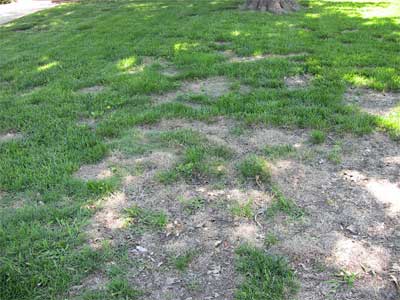
Answer: You would need to wait four months before reseeding, but it’s already way too warm for fescue to establish. Next possible time is going to be early September. That’s actually the one time that it really is successful. Wish I had better news. I’ve not seen fescue sod, but I’m sure there is some out there somewhere.
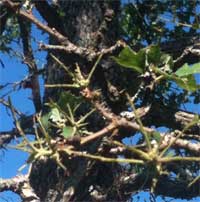
Question: What might have chewed all the leaves off hundreds of post oaks within just a few days? Other trees nearby are just fine. P.W., N.W. Parker County.
Answer: It’s almost assuredly cankerworm damage. They’re small, looping types of caterpillars that hang from single threads. They feed voraciously for a week or two, then they are finished. They must be damaging to some degree, but affected trees soon leaf out again. There is only one generation of the pests each year. Your trees should be back to normal before long. No need to spray now.
Question: Both of my magnolias were planted six years ago. Why would one be thinner than the other? What can I do? L.W., Mansfield.
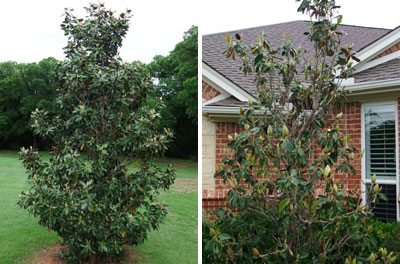
Answer: The thinner tree either has needed more nitrogen or more water at some point in the past. Those are the only two things that would account for the differences. Step up the care you give the thinner tree, and you should see it catch up.
Question: What is this fine winter grass that takes over as the St. Augustine is trying to green up? How can we prevent or eliminate it? J.R., Garland.
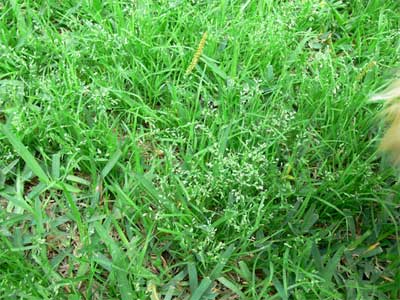
Answer: This is annual bluegrass, Poa annua. It germinates in the fall, grows over the winter and goes to seed in the spring. Your only means of dealing with it will be to apply a pre-emergent herbicide such as Dimension, Halts or Balan in early September. Once you can see the small grass seedlings growing in the fall or winter, you’re too late for another entire year.
Question: My Asian jasmine has gradually been getting worse. What should I do? L.C., no city given.
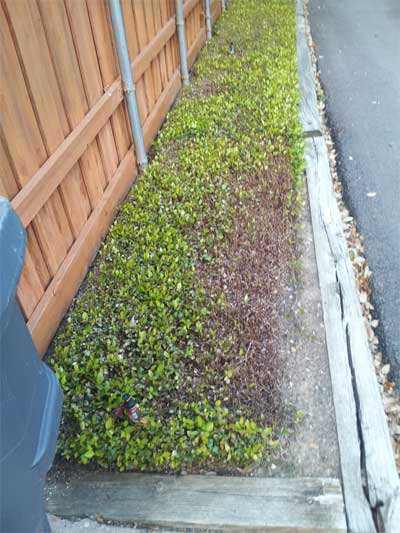
Answer: I have never in my life seen any insect or disease bother Asian jasmine. This almost has to be drought damage, so proper watering is the key to turning things around. Apply an all-nitrogen lawn fertilizer, too, to promote vigorous new growth.
Question: My fall mums are growing and blooming now. Should I trim them back, so they will bloom better in the fall? R., no city given.
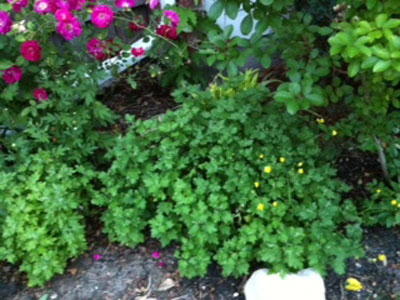
Answer: You can enjoy the spring flowers for a while, but by mid- to late May, you’ll want to remove them. Trim the plants back by half, and apply an all-nitrogen fertilizer to promote vigorous vegetative growth. They do bloom in the spring, too, because day lengths in spring are the same as they are when mums normally bloom in the fall.
Question: My live oak is 6 years old, and I’m seeing these holes in the trunk. What causes them, and what should I do? M.R., Lucas.
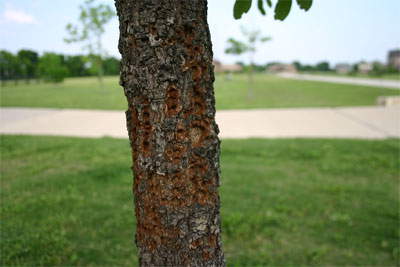
Answer: That’s activity of sapsuckers or woodpeckers. Normally, I would say that they’re of no special threat to trees (I have them in my own pecans and live oaks), but this is to excess. Either wrap the trunk with paper tree wrap from the nursery, or apply Tree Tanglefoot to discourage the birds. It’s illegal to harm them.
Question: How can we eliminate these patches of thorny weeds? They’re everywhere. B.E., no city given.

Answer: Apply a broadleafed weedkiller with a fairly fine mist spray pattern. Don’t mow for several days before or after you treat. It should eliminate any non-grassy weed.
Question: What would have caused our post oak tree to shed bark? It looks healthy overall. D.F., Colleyville.
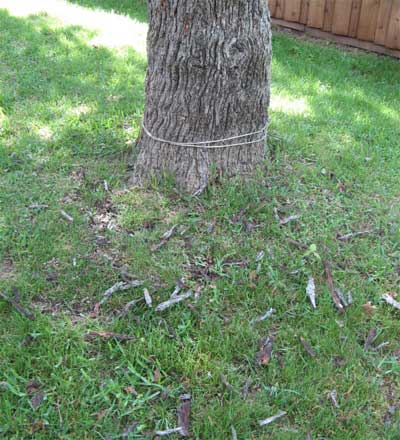
Answer: We referred your question to our tree expert, Steve Houser of Arborilogical Services, who said that your tree appears to be a post oak and that the bark shedding is probably not cause for alarm. Here’s his note: “The problem is most likely to be squirrels that peel off small pieces of the bark. The photos do not show any significant damage to the vascular system and it appears to be more superficial in nature. No cause for alarm unless the damage becomes more extensive in the future. Woodpeckers can cause this type of damage, but it is typically in a tree that has active borers in the trunk.”
Question: I’ve had this problem on my trees for several years, but this year is the worst. The leaves curl up, mainly in the spring. What would cause this? No name, no city given.
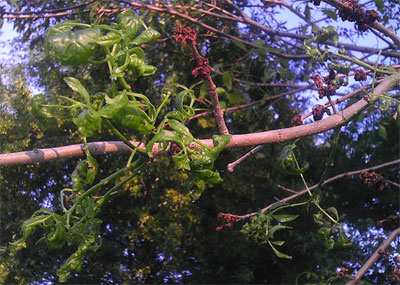
Answer: Since your photos show several different types of plants, all with some issue of stress, my best guess would be that you’re applying some type of weedkiller or weed-and-feed fertilizer each spring. This really looks like some type of chemical burn. Hopefully it will abate as time moves on.
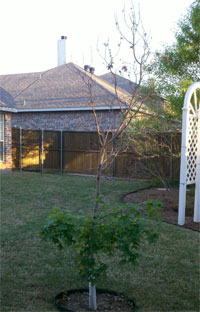
Question: In the last issue, you talked about a tree that was only leafing out at its base. You talked about cutting it back completely. If we do that to our Shumard red oak, it will be only 3 feet tall. Is it possible it will come back next year? Should we replace it? We notice that the live tissue is only from the part of the trunk that we had wrapped. Should we have wrapped farther up? K.L., Flower Mound.
Answer: You might as well cut this tree back to the best, most vertical shoot that remains. If you can find one that emerges from the trunk at a fairly narrow angle, it will grow and fill in the bend as the trunk thickens. The top will not green out again. Guaranteed. Whether you replace it or not will be your decision. Wrap up to the lowest branches at the time of planting. If it were my tree, I’d try trimming, thinning and training the regrowth for the rest of this spring and summer. If I decided to replace it, I’d do so in October.
Question: What is wrong with my Shumard red oak’s leaves? Notice how swollen the veins are. B., Sachse.
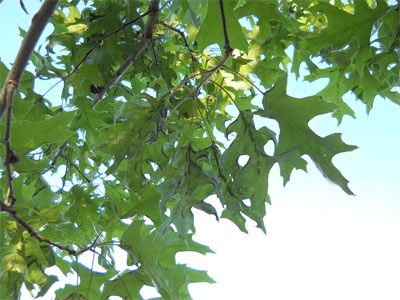
Answer: This is fairly common this year. It’s vein pocket gall, one of scores of different types of insect galls that attack different oak species. It is not harmful, and there is no control. Some leaves will be lost, but the tree will be just fine in the long run.
Question: Our large oak tree lost almost all of its leaves in a major hailstorm. Will it come back? What can we do to save this tree? W.S., McAllen.
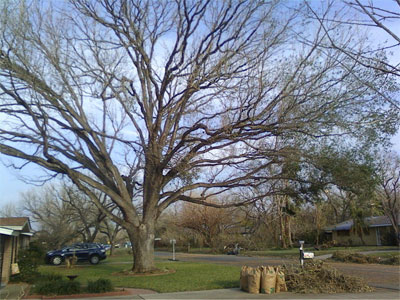
Answer: It will leaf out again fairly quickly. However, the branches that are fairly horizontal will have bruised tissues that may decline over time. Don’t be surprised if you see dieback over the next several years. You might want to have a certified arborist look after the tree, but it should be fine over time.
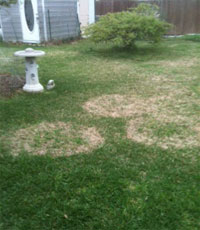
Question: I get these round patches in my lawn every spring and fall. The grass eventually grows back in. What is it, and how do I deal with it? No name, Bedford.
Answer: This is a graphic example of the fungal leaf disease known as brown patch. It kills the blades where they attach to the runners. The runners and roots remain healthy, and the grass will grow out again soon. It is unsightly, but rarely fatal. Prevent it with an application of a turf fungicide when you first see it showing up – long before the actual browned patches are visible. First signs will be yellowed blades that are decayed where they attach to the runners. You’ll rarely see it in the spring in North Texas, because St. Augustine blades normally turn completely brown with the first frost. It’s far more common in October. South Texas readers will see it both seasons.
Question: Some of the muriatic acid cleaner we put on our pool must have sprayed onto our vegetables, roses and an oleander. Will they recover? K.F., Hickory Creek.
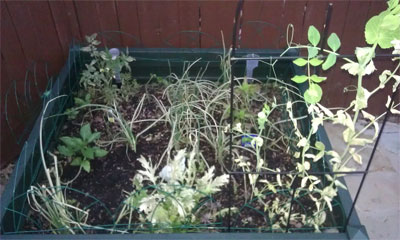
Answer: The roses and oleander will, but it’s possible you have set the vegetables back so badly that they may not produce before it turns hot. Keep them moist, and wait and see.
Question: We had a lovely magnolia until Hurricane Rita knocked it over in 2005. Last year, I planted another one, but it’s grown very little. Is it the cemetery soil, or what else might be restricting its growth? Should I simply start over? J.K., Woodville.

Answer: This tree looks fine, especially considering the awful year we had last summer and fall. Apply a high-nitrogen fertilizer to it to promote new growth, and keep it moist all summer long. Don’t start over now! By the way, you are really putting the tree at risk by having it staked only in one direction. You want to have three stakes equally spaced, with one facing due south. Pad the trunk to prevent rubbing, and have the rope or cable at least halfway up the trunk. Keep all cables taut at all times. You can remove the staking after a couple of years.
Question: I found some grubs in my garden. I think they attacked my grass, so I applied an overnight poison. Should I reapply it? J., no city given.
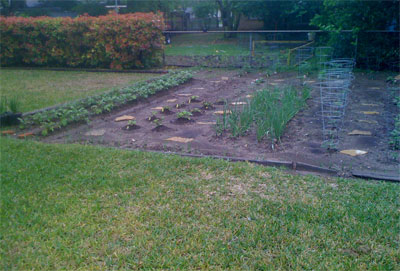
Answer: White grub worms’ life cycle of damage is that they hatch from eggs in mid-summer, then feed actively on grass roots during August, September and October. They have done most of their damage by November 1, so treating after that time is useless. Also, you have to have more than four or five grubs per square foot before you’ll see visible damage. My bet is that this grass either suffered chinch bug or drought damage last summer and fall. It’s not nearly as likely to be due to white grub worms.
Question: How can I eliminate wild violets? 2,4-D didn’t seem to bother them at all. C.P., Keller.
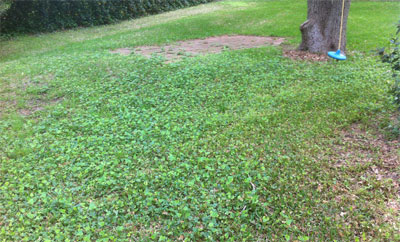
Answer: Because of their funnel-shaped leaves and the fact that sprays bead up and roll off, wild violets are not easily controlled. The 2,4-D products are absolutely the correct products to use, but apply the herbicide with a fairly fine mist pattern. Add one drop of liquid dishwashing detergent per gallon of spray to help hold it on the leaf surfaces. Don’t mow for several days before or after you treat, and do be patient. It should work well given those modifications.
Question: Is there any way to get this rose bush to bloom more than one time per year? G.B., no city given.
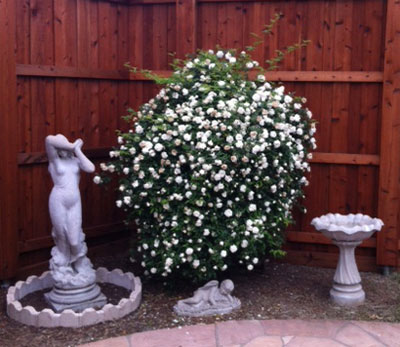
Answer: Some rose varieties are spring-only bloomers. They produce their flowers on cane growth they made the prior summer. Trim and reshape them after they bloom, and wait for next year for the annual flowering. Or, change out to an everblooming type. I can’t see this one well enough in the photo to ID it, but it looks similar to the highly fragrant white Lady Banksia rose. If so, that one is a real keeper.
Question: What is going on with my live oak tree? I’ve attached several photos. P.D., Allen.
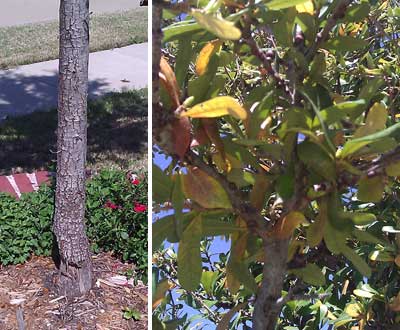
Answer: The trunk damage is from some type of mechanical injury, either from a line trimmer or mower wheel, or from some type of sunscald and subsequent decay. Hopefully, the tree can recover from that, but it’s been badly wounded. The small, half-globe insects are a fairly common scale insect. Horticultural oil applied in the winter, or Merit systemic insecticide applied during the growing season will help with them, but they are not a major threat.
Question: What type of groundcover would you use beneath these live oaks? D.B., no city given.
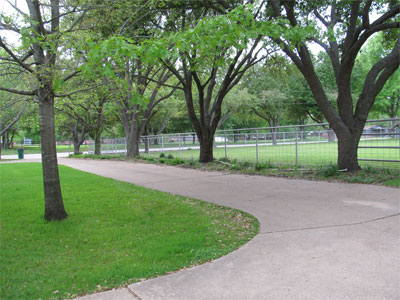
Answer: In a heartbeat, I’d have mondograss or liriope. Both love the shade, and neither would have to be edged at the fence boundary. You can plant them at any time.
Question: My bermuda lawn almost looks like it has crop circles. What might cause this, and what can I do to have a better lawn? I try to stay on top of it with good maintenance. Should I consider reseeding the bare areas? T.N., Marfa.
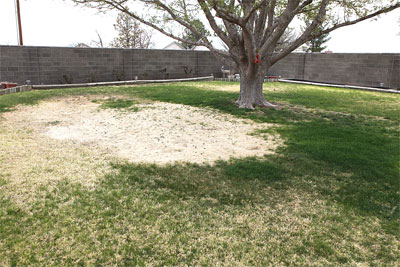
Answer: Wow! I’m not sure I can identify the problem precisely, but it’s hard to ignore the extreme drought you folks have been under for the past 24 months. Reseeding would not be easy. It would be much better to dig 4-inch squares of healthy bermuda sod from other parts of your lawn, then transplant them into the bare spots. They will fill in more quickly, and they’ll be much easier to establish than seed. You have to rototill for new seedings, and that’s hard to do within existing turf.

